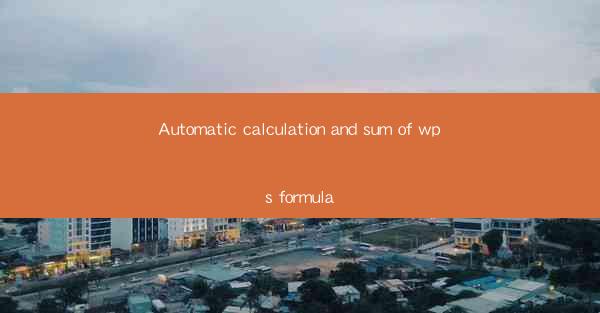
Introduction to Automatic Calculation and Sum of WPS Formula
In today's digital age, the use of spreadsheet software like WPS has become an integral part of various professional and personal tasks. One of the most powerful features of such software is the ability to perform automatic calculations and summing of data. This article aims to explore the functionalities of WPS formula, focusing on how it simplifies the process of calculating and summing data.
Understanding WPS Formula Basics
WPS Formula, similar to Microsoft Excel, is a set of predefined functions and operators that allow users to perform calculations on data within a spreadsheet. These formulas can range from simple arithmetic operations like addition, subtraction, multiplication, and division to more complex statistical, logical, and text functions. Understanding the basics of these formulas is crucial for anyone looking to leverage the full potential of WPS.
Simple Arithmetic Calculations
One of the most common uses of WPS formulas is for simple arithmetic calculations. Users can easily add up numbers using the SUM function. For example, to sum the values in cells A1 to A10, the formula would be `=SUM(A1:A10)`. This function can also be extended to include multiple ranges or even non-adjacent cells.
Advanced Calculations with Functions
WPS offers a wide range of functions that can be used for more advanced calculations. For instance, the AVERAGE function calculates the average of a range of cells, while the MAX and MIN functions find the highest and lowest values, respectively. Functions like VLOOKUP and HLOOKUP are useful for searching for specific values in a dataset and returning corresponding values from another column.
Text and Logical Functions
In addition to numerical calculations, WPS formulas also include text and logical functions. The CONCATENATE function, for example, merges text from different cells into a single cell. Logical functions like IF, AND, and OR allow users to perform conditional operations based on specific criteria.
Summing Data with Custom Formulas
While the SUM function is a straightforward way to add up numbers, there are times when more complex formulas are needed. Users can create custom formulas using a combination of functions and operators. For instance, to calculate the total sales tax for a list of items, a formula might look like `=SUM(C1:C10)0.08`, assuming the sales tax rate is 8%.
Using Array Formulas for Dynamic Calculations
Array formulas in WPS are particularly useful for dynamic calculations that involve multiple rows and columns. These formulas can perform calculations on entire arrays of data without the need for manual adjustments. An example of an array formula is `=SUM(IF(A1:A10>100, B1:B10, 0))`, which sums the values in column B where the corresponding values in column A are greater than 100.
Conclusion
The automatic calculation and summing capabilities of WPS formulas are essential tools for anyone working with data in a spreadsheet. From simple arithmetic to complex calculations and text manipulations, WPS provides a robust set of functions to handle a wide range of tasks. By understanding and utilizing these formulas effectively, users can save time, reduce errors, and make more informed decisions based on their data.











